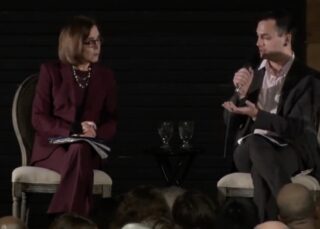
Governor Kate Brown spent about an hour with members of the City Club of Portland today. At the event, a preview of the 2020 legislative session, Brown fielded two questions about the controversial I-5 Rose Quarter project.
As we reported Thursday, the Oregon Department of Transportation and their bosses at the Oregon Transportation Commission (OTC) are facing an intense barrage of questions and concerns from elected officials and community groups over their plans to expand I-5 between I-84 and I-405.
“How do you reconcile these big investments in fossil fuel infrastructure with a climate justice vision?”
— Colin Jones, moderator
The first question for Governor Brown came from Chris Smith, a noted transportation reform activist who happens to have a seat on the City of Portland Planning & Sustainability Commission and has just launched a campaign for Metro district 5.
Chris Smith:
“You said yourself transportation is the largest sector of greenhouse gas emissions from the state. Last year, during the comment period for the Rose Quarter freeway expansion, more than 2,000 comment were received. 90% of them opposed the project or asked for a full Environmental Impact Statement — yet the OTC appears poised to move forward without an EIS. First question: Do you expect the commissions you appoint to listen to public comments? And second question: Will you ask for an EIS?”
Advertisement
Governor Brown:
“As I mentioned in my remarks, transportation is 40% of our greenhouse gas emissions statewide and the best strategy to reduce carbon in transportation is an economy-wide, market-based approach with enforceable limits. And that’s the proposal on the table in the legislative session [referring to the latest version of Oregon’s cap-and-trade bill]. Absolutely, we must address the Rose Quarter issue to increase safety and at the same time we can do this with a layer of congestion pricing which should reduce carbon emissions overall.
In terms of your question of do I expect members of my boards and commissions to listen to public comments… Absolutely, and I believe that the OTC is doing that.”
Then moderator Colin Jones asked the Governor a similar question (based on “dozens” he received on Twitter before the event):
“You talked about the transportation bill [HB 2017], which included significant investments in public transit — which is what you tend to talk about — but it also included a couple hundred million in fossil fuel infrastructure in the form of the Rose Quarter freeway expansion and a lot of the folks see the CRC 2.0 project coming to life again. So, how do you reconcile these big investments in fossil fuel infrastructure with a climate justice vision?”
Advertisement
Governor Brown:
“Transportation is 40% of our greenhouse gas emissions. We need to make sure we reduce carbon in transportation through an economy-wide, market-based approach. I think we can do both, honestly. The investments in the Rose Quarter… Safety: We can do this in a way with a layer of some type of congestion pricing will provide safety, as well as carbon emission reductions — obviously when people are idling on I-5 at that particular pinch-point you’ve got a lot of congestion, a lot of emissions happening there.”
Reached after the event, Chris Smith shared his thoughts on the Governor’s answer to his question: “She suggested that the Oregon Transportation Commission is doing a good job listening. That’s hard to reconcile since they are neither stopping the project, nor do they appear to be headed to an Environment Impact Statement.”
There are a few notable takeaways from Brown’s answers.
She answered both questions with nearly identical talking points. This makes it clear she spoke from prepared remarks. The inclusion of congestion pricing in her answers gives more momentum to price freeway lanes as soon as possible. While some local electeds like Portland Commissioner Chloe Eudaly and Metro Council President Lynn Peterson (who was in the audience today) have explicitly called for pricing before construction begins, Brown stopped short of doing so today. When it comes to the safety rationale for the project, that’s dubious to say the least.
Brown’s remarks today make it clear she feels reducing idling (by alleviating congestion) is a climate change strategy. That would align her directly with the newly named ODOT Director Kris Strickler. But context matters. If she made these remarks in the context of a question about investments in alternatives to driving, she would win fans among transportation reform advocates. But in the context of questions about a project that will expand lanes on a freeway, some might think she either isn’t aware of induced demand, doesn’t believe in it, or that she’s simply disengaged from the project and is comfortable parroting ODOT talking points. (Note: Brown’s Transportation Policy Advisor Brendan Finn starts a new job as Director of ODOT Office of Urban Mobility and Mega Project Delivery (being formed specifically to “deliver” the I-5 Rose Quarter project) on March 1st.)
The Governor also didn’t answer Smith’s question about the EIS. When I asked the same question about a month ago, her office said, “The Governor appreciates the OTC taking time to address some of the local partnership issues articulated in her letter and will support the federal environmental review path they decide on.”
— Jonathan Maus: (503) 706-8804, @jonathan_maus on Twitter and jonathan@bikeportland.org
— Get our headlines delivered to your inbox.
— Support this independent community media outlet with a one-time contribution or monthly subscription.



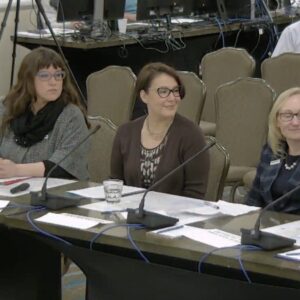
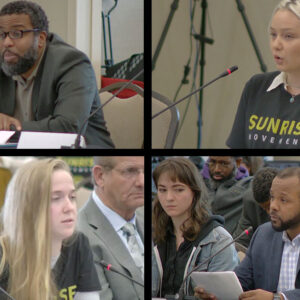
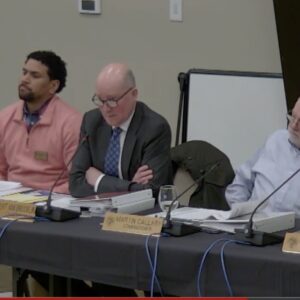
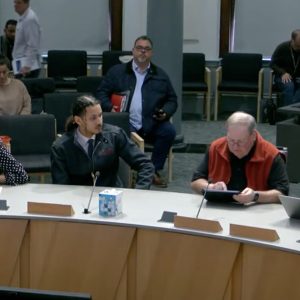
Thanks for reading.
BikePortland has served this community with independent community journalism since 2005. We rely on subscriptions from readers like you to survive. Your financial support is vital in keeping this valuable resource alive and well.
Please subscribe today to strengthen and expand our work.
Disappointing.
Especially since Chris’ questions were so well formulated.
Gov. Brown sure sounds like a climate denier to me. All that “we can do both” strikes me as lame justification for wanting to spend the money on highway widening even though it won’t work and tolls and congestion pricing will still be necessary. They all (Brown, ODOT, consultant team) know that change is coming and this huge, expensive project will not be a part of the solution, but no one in authority is willing to pull the plug on this waste of money and resources. They are tool invested in the narrative of have spent their time and money to date in a responsible and sustainable way. Stopping this project is seen as an admission of ignorance and complicity so they just want to get it built as quickly as possible so they can look back in 5 years and say “if only we knew then what we know now!”
“no one in authority is willing to pull the plug on this waste of money and resources.”
This.
Denial or not, will Brown do the right thing? Being a career politician making any decision w/o a CYA will not happen. Having commissions and department heads to take the heat makes for a clean resume. Letters/emails and phone calls , if in LARGE numbers will make her rethink the project:https://www.oregon.gov/gov/pages/share-your-opinion.aspx
Chris for gov.
With democrats like Governor “Bike Tax” Brown, who needs enemies?
Given the democratic party’s terrible track record on the climate crisis, who needs democrats.
Looks like they are going to ram a cap and trade program through. The carrot they are throwing rural Republicans are more freeway funding. That is some real political bullsh!t.
If memory serves me well, the Mt Hood Freeway was killed by a 3-2 vote of Portland City Council. Have the rules changed? or am I mistaken? How many votes do we have on Council to pull this plug? Two? Seems like a Yes or No question for all the folks running for office this year.
What role does City Council have here? This is, as we have learned to say, “an ODOT facility,” after all.
These sources say the Council “withdrew support” (by a 4-1 vote). Then the County did the same. I can’t find details but my inference and understanding is that, just like today, it was officially a State project but hard to do politically without local support. So the City probably couldn’t officially kill it on their own, but made it impractical to go on.
Sorry, those sources:
https://oregonencyclopedia.org/articles/mt__hood_freeway/
https://www.wweek.com/portland/article-4212-highway-to-hell.html
Economy-wide and market-based – well we’ve heard from the Republican candidate for Governor. Is there a rebuttal from a Democrat? What’s that hun? Shh not now, I’m typing on the internet.
Paul Krugman refers to zombie ideas, and even has a book coming out this week on that topic. Our governor answered those questions with zombie ideas, notions that have been killed off by evidence but keep coming back to eat brains. I have to ask, what was served for lunch at city club?
Paul Krugman is a zombie idea.
“The investments in the Rose Quarter… carbon emission reductions”
One thousand times no.
“obviously when people are idling on I-5 at that particular pinch-point you’ve got a lot of congestion, a lot of emissions happening there.”
I am so sick of this absurd, obsolete, mendacious trope that equates idling with what we are up against: climate change.
We should not accept this sort of crap from our leaders.
To invoke idling as the thing that the Rose Quarter rathole will fix , must solve, is laughable. Does she take us for fools?
Idling is not wasting more gas and sending tons more pollutants into the air than driving. I’ve idled for 6 hours when stuck on the pass at the California border. I started with about 1/4 tank and still has gas to go a mile to the gas station in the morning. I could not have driven for 6 hours on less than 1/4 tank of gas. Had I been driving for 6 hours I would have put out a lot more pollution.
As has been shown people will drive more and waste more gas when the roads are clear.
Make no mistake, idling is terrible for local air quality, it burns/wastes fuel, is dispiriting for those inside the metal boxes, etc. But we need to be crystal clear, strategies to move more cars faster through congested stretches of our infrastructure while they may alleviate some idling in the short run (brief, qualified, relative improvement in local air quality) the first order result of this is to enshrine automobility even further, prioritize internal combustion, move more cars, burn MORE gas, all of which directly hastens the effects of climate change.
We need to envision doing an end run around this absurd set of trade offs. An end to automobility gets us out of this lose-lose situation.
This is what you voted for. But I don’t totally blame Kate Brown.
“This is what you voted for”
Not entirely fair. In a democracy-worthy-of-its-name, we don’t vote and then sit on our hands for four years. We hold our leaders, each other accountable every day. #45 imagines himself above criticism, above the law, but most leaders, surely, can appreciate that they are accountable to their public, not just to those who elected them but to all people in their jurisdiction.
“But I don’t totally blame Kate Brown.”
Say more. Who do you blame? What do you suggest?
Oh really? I don’t think anybody can hold Kate Brown accountable. She answers to her PERS buddies and no one else.
“Too many men
There’s too many people
Making too many problems
And not much love to go round
Can’t you see
This is a land of confusion…..
Phil Collins
To be more accurate, Genesis.
You’re correct.
In other words, she is in favor of the project but didn’t want to say so.
Why shouldn’t the City of Portland be taking the heat on this, instead of ODOT? Most of the jacked up cost is due to their urban renewal scheme. ODOT typically does things pretty cost effectively; In Troutdale they are actually rebuilding a 1/2 mile stretch of I-84 ON A NEW OVERPASS for (reportedly) $19 million. I-5 in the Rose Quarter also has, almost, enough room for three lanes. But I’m sure to meet federal requirements they need wide lanes. Nonetheless, It is not an $800 million deal. They would definitely have to reengineer all overpasses, so that columns and bulkheads could be moved. IMO, it would be better accomplished as several smaller projects. The continuous lanes between major interstate connections make sense; I’m not sure that double lanes from the major routes are needed, though.
Secondly, why is METRO intervening in this? Interstate transportation issues aren’t their domain, and urban renewal is quite a stretch.
Finally, people who keep hollering climate change should observe the impact that our skyrocketing population growth is having. PGE relies upon natural gas or coal for 60 percent of its power and has in recent years added two natural gas plants in the Clatskanie area. And then there is the natural gas directly consumed in heating and cooking. Heating BIG buildings 24/7 takes lots of energy, in case you weren’t aware. The production of concrete products contributes 8 percent to GHG, even before the building is in use.. But I guess if you want a service economy instead of the practical, old fashioned economy, GHG is what you’re gonna get.
“Why shouldn’t the City of Portland be taking the heat on this?” Who says they aren’t also taking heat on this? It’s ODOTs project though and they’re the ones that have to justify the cost increases. This increase is not for an improved urban renewal scheme it’s for the same plan ODOT proposed in 2017 but adjusted for new factors.
“I-5 in the Rose Quarter also has, almost, enough room for three lanes” What are you basing that on? Yes there are federal requirements for lane widths are you suggesting we should change them so we can add more lanes? Have you considered the safety issues that might create or problems for large commercial vehicles?
Why is METRO intervening in this? Well I think they would disagree with your assessment that these things aren’t in their domain. What do you think METRO is for? The measure that voters passed to establish METRO was pretty broad in it’s language and what METROs primary mission would be. Basically regional planning and any services the voters or legislative body thought they should manage.
I don’t really understand your last point. Are you saying we should let this project go through because of our economy and growing population? And it doesn’t really matter what we do to curb emissions?
“The continuous lanes between major interstate connections make sense”
Not here in Oregon they don’t. They just removed the continuous lane that connected from I-84 west to I-205 north.
And with the construction of I-205 you’re supposed to be driving around the city and not through it on I-5, basically making the I-84 and I-5 connections less used and not in need of upgrades.
ODOT is not in the business of managing transportation for the people, their business is catering to motor vehicle speed. They do this by building what they know, horrible infrastructure.
“The production of concrete products contributes 8 percent to GHG”
And they’ll probably be using a lot of it to rebuild a freeway. A freeway that is open 24/7 no matter if anyone is using it.
Meanwhile, in the Monday Roundup we’re learning that they’re starting to use stronger wood in place of cement when constructing large buildings.
Natural Gas is arguably worse than coal for GHG emissions.
https://phys.org/news/2019-07-natural-gas-boom-collison-climate.html
Anyways, in a few years most cars being sold will be EVs anyway so its a bit of a moot point. They certainly can’t come soon enough to help our emissions.
The lack of credible Republican opposition is what allows the Guv to take these positions. If a centrist Republican existed, who could challenge the governor with sane policies and positions, she would need to move left. But since the Republican party has become right-wing crazy, Brown can move right with no fear of a backlash – she’s the only one Dems have.
Another alternative – as “credible Republican” seems to have gone the way of the Dodo – is implementing STAR voting as proposed in the Lane county ballot last cycle, including doing away with the primary. This would allow ideas on the left to pull the center-right favorites without any spoiler effect/viability concerns (STAR does away with those).
Out two-party system surely doesn’t help. Brown has a lot of “accomplishments” on her list but most are just the usual hype. Next election I’m voting for anybody but Brown.
You must be joking.
The original fixed-price cost of replacing the Sellwood bridge was $90 million, a bid made by Bechtel, an international firm not in the habit of losing money.
Under ODOTs aegis we ultimately spent $320 million, a fraudulent sum four times what was required, an excess even greater than the $200 million ODOT poured into the rat hole of the Columbia River Crossing.
Until someone figures out how to clean house at ODOT this garbage will continue.
We need another bridge over the Columbia west of I-5 and route the highway through Hillsboro and hook the new I-805 road into I-5 north of Keizer. This new section of highway will eliminate more CO2 from the air than any I-5 “widening” project at the rose quarter.
This new stretch of road would take traffic off I-205 and I-405 in addition to I-5 and they could even put a bike lane on the side of it!!! I would pay a toll on this stretch of road without any question and know that I could get from Vancouver to Beaverton in 15 minutes (sound interesting?).
Oregon and Washington needs this more than any other project. Re-routing of traffic will make everyone’s commute more tolerable. After it opens we can close one of the I-5 bridges for replacement and after that is replaced, fix the other one. No max on the I-5 bridge to keep Vancouver happy.
“This new section of highway will eliminate more CO2 from the air…”
Not how this works.
Sorry.
The leaders who got us into this mess are not the ones who are equipped to get us out of it.